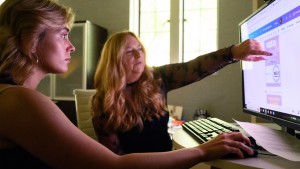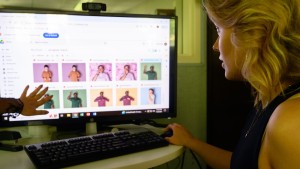Having started college with aspirations of attending medical school, Leah Fanello ’25 never imagined she would spend her last summer as an undergraduate in the photography studio.
But after transferring to Kenyon from a large, public university and switching career goals, she was inspired to immerse herself in American Sign Language (ASL), approaching it through the dual lenses of art and community connection.
As the College’s Community Engagement Summer Scholar, Fanello used her background as a psychology major and studio art minor to address a lack of free resources for learners of ASL — the third-most used language in the United States — by artistically photographing and filming area residents demonstrating signs in ways that aid in sign recognition and recall.
She pursued the work this summer with the help of her mentor, Associate Professor of Psychology Tabitha W. Payne, as well as Ohio creators Jo Westfall, a multimedia artist, and Jennifer Enskat, an actor and filmmaker.
Photography sessions began with Payne — a cognitive experimental psychologist and chair of the College’s psychology department this year whose brother-in-law is Deaf — teaching volunteer models from Knox County select ASL signs. Volunteers were guided to sign in segments of movement so that Fanello and Payne could capture every motion. The series of photographs were then edited and placed next to each other with small arrows representing continuous movements.
Before being photographed, some participants were asked to dress up to reflect their sign in the hope that it would make it easier for others to learn. For example, a participant signing SUNSHINE (ASL signs are written in all caps to distinguish them from written English) dressed in a yellow dress and white hat after Fanello asked them to wear “whatever (makes) you think of the sky and sunshine.”
Sometimes, Fanello and Payne also paired photos of signs with an image of the concept represented. For the sign FLOWER, they included a photograph of a garden flower on the left and a photo of the ASL sign on the right.
The order in which the images are presented is important because of how the brain processes visual information: images from the right visual field — a combination of the information from the right side of both eyes — are processed on the left side of the brain, which the majority of people use for language processing, according to Payne’s psycholinguistics research. By positioning the sign to the right of the concept, the researchers aim to access the language processing left hemisphere, promoting better comprehension.
Deaf and hearing signers have been providing feedback throughout the process as Fanello and Payne work to create a book showcasing their project — which will be continuing this semester — and videos that can be shown on film kiosks around campus.
Printed materials will be used as learning tools in two of Payne’s courses, “Psychology of Language” and “Language Disorders,” a class that inspired Fanello to work with Payne and take part in this project. The two also taught a class to community members through The Annex in Mount Vernon on how to find ASL resources online and photograph signs themselves.
Fanello said she is excited to be part of a project that promotes ASL education in Knox County in a way that is beautiful, memorable, and accessible.
“Engaging with the community this summer has made me more appreciative of the Kenyon community and the opportunities that the College has given me,” she said. “Being able to teach a class showcasing my work and photography processes as well as having a book publication means a lot to me as I am finally able to share my work with a larger crowd.”
This article was written by Abigail Rionn Conklin ’27 as part of the Hoskins Frame Summer Science Writing Scholars program.



